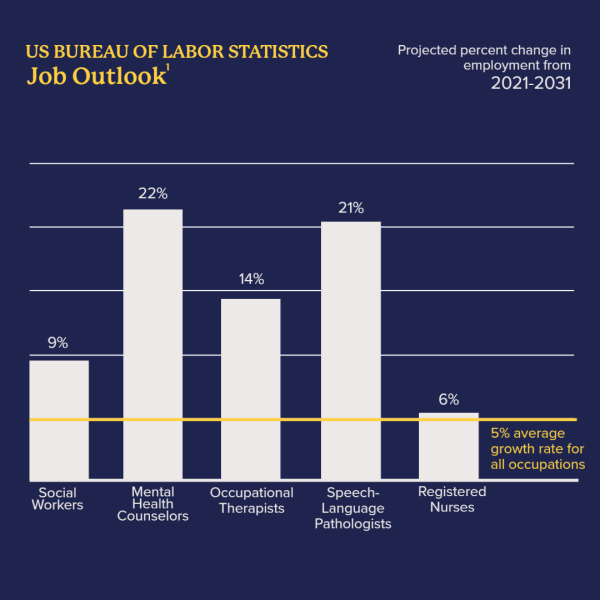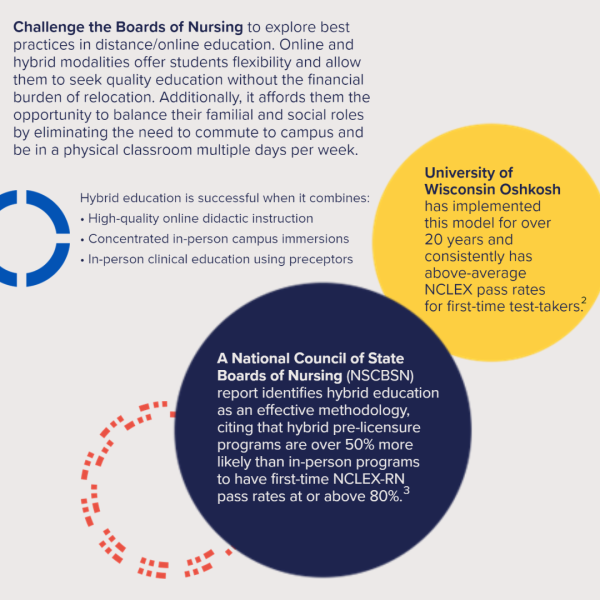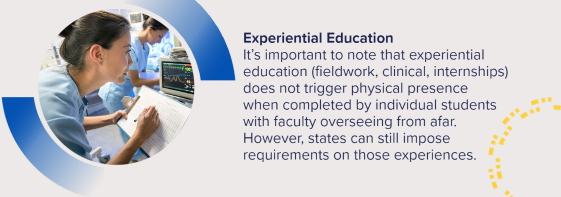
Does Regulatory Complexity Stifle Innovation in Higher Education?

For degree programs that lead to professional licensure, regulatory complexity may be impeding educational innovation and growth opportunities for online pathways.
Online degree programs are helping to upskill and reskill individuals across all geographies and walks of life, enabling students to continue in their employment and/or social roles while seeking their degrees. Increasingly, degree programs in health professions and social services are creating distance or online degree pathways to meet the needs of learners and fill critical shortages in specific disciplines. But the devil is in the details when it comes to getting these programs up and running.
The regulation of online degree programs is multifaceted. Depending on the discipline, both state authorities and professional organizations may regulate institutions and set standards on individual programs to ensure that students are enrolling in legitimate educational offerings – and, in the case of degrees leading to professional licensure, these regulatory bodies set quality standards to safeguard the licensed professional discipline. But with layers of complexity and redundancy, unclear or unwritten rules, and prohibitively long processes, this oversight may be slowing much-needed growth and innovation to the detriment of universities, students, and high-demand fields in need of qualified graduates.
The demand for online or distance program formats has increased with Americans’ desire for remote and flexible schedules following the onset of the COVID-19 pandemic, especially among the adult learners most likely to be pursuing advanced degrees. According to a survey of prospective adult students conducted by SimpsonScarborough and LinkedIn, 80% of adult learners are interested in online education (and 40% have a decreased interest in in-person options). These adult learners are pragmatic in their reasons for going back to school - seeking tangible skills and competencies to help them advance or change fields and thereby increase earning potential and job stability.
Students seeking a solid return on their investment in higher education frequently seek a degree that leads to professional licensure, such as those in healthcare, teaching, or social services. Earning a degree that leads to licensure provides ample opportunity for job security and, often, decades-long career pathways, with multiple growth opportunities as experience and additional credentials are built upon the initial licensure.
However, despite student interest and the abundant need for licensed professionals, especially in health and social services, online program offerings in many of these fields are far from widespread. Moving an established on-campus university program to a distance or hybrid format is not always straightforward, especially when it involves a discipline that leads to professional licensure. Regulatory oversight, while necessary, creates challenges and often prohibits universities from expanding student capacity with distance or hybrid programs. The rigor of regulatory oversight varies by discipline and, in some cases, may inhibit educational innovation and enhanced enrollment capacity. As there is a market need for licensed professionals, the advent of online and hybrid educational programs – sought by students and proven to be efficacious – necessitates re-examining aspects of regulatory oversight that may be unnecessarily limiting capacity and confining modalities. Regulatory bodies can impact shortages of essential health and social services professionals by being receptive to innovations that expand program capacity and evaluating them from a data-driven perspective that leans on measurable student outcomes and other evidence of effectiveness.
State-imposed Complexities
To offer a professional degree that leads to licensure, universities must first understand and comply with the two layers of regulations promulgated by their own state’s higher education authority and professional boards. These two layers of regulation vary between each of the 50 states (plus the District of Columbia and U.S. Territories) and are sometimes outdated regarding the nuances of hybrid or online degree programs.
State Higher Education Authorities
Each state or jurisdiction has its own higher education authority that grants institutions the ability to confer degrees. These authorities regulate the creation of new educational institutions and have quality and reporting standards for the ongoing maintenance of colleges and universities within their jurisdiction. Each of these higher education authorities devises and implements its own rules for the approval and implementation of online degree offerings. Before an institution can offer a program with an online pathway, it must seek approval from the relevant higher education authority or, at a minimum, provide prescribed notification. For degrees that lead to professional licensure, additional state regulatory bodies may also have jurisdiction.
State Professional Boards in the Home State
Health and social services disciplines such as nursing, occupational therapy, counseling, and social work are regulated by professional boards within each state, often focusing on licensure, scope of practice, continuing education, and adjudication of complaints. Additionally, some boards may oversee educational programs that lead to licensure in their discipline to ensure programs have the resources and structure needed to promote student success. However, in doing so, they sometimes trail behind in academic innovation, likely due to limited resources explicitly dedicated to the dynamics of educational environments and evolving best practices.
For example, state boards of nursing (BON) are often very prescriptive towards pre-licensure nursing programs. The BON often sets parameters on the use of online instruction for didactic coursework, the use of preceptors in the clinical setting, the ratios of clinical faculty to students, the number of students permitted to enroll, and the use of simulation to fulfill clinical hours.
In addition to the unique rules and oversight imposed on nursing programs across 50+ jurisdictions, there is also a phenomenon of “silent rules.” There are certain subjects, such as the use of preceptors, for which a state board may not have established regulations. Because changes to pre-licensure nursing programs require state BON approval, a university might present proposed changes to a program, outlining compliance with the existing rules and regulations, only to be advised that the proposed plan is not approved for implementation because there are no written rules addressing the unique and innovative aspects of a distance program offering.
While it varies widely by jurisdiction, approval for new programs, new program pathways, or the use of innovative methodologies can take months or years - especially when the review and approval processes are undocumented or unclear. Whether this process is swift or drawn out, it is only when program approvals are obtained that a university can move on to the next stage of online growth - securing approval to enroll students across state lines.
Crossing State Lines Requires Compliance with Multiple State Agencies
Each state, U.S. Territory, and the District of Columbia has its own higher education authority regulating colleges and universities within its jurisdiction. Each of these authorities has different criteria for allowing universities outside their jurisdiction to enroll students residing within it. As such, a university must navigate and comply with 50+ different sets of rules outside of its home state in order to enroll students from each “host state.” This is a detailed and cumbersome process that requires dedicated resources.
With the shift to increasing options for distance and online programs that cross state lines, the National Council for State Authorization Reciprocity (NC-SARA) was established in 2013 as a nonprofit organization to expand access to educational opportunities by ensuring more efficient and consistent regulation of distance education programs. Through NC-SARA, states join regional compact agreements and ultimately agree to a common approach for state authorization of distance education. Through this commonality commitment, the quality of distance education programs is improved nationwide, students can more easily access distance education programs across state lines, and states are more coordinated on higher education opportunities. Currently, NC-SARA comprises 49 states (all except for California), the District of Columbia, Puerto Rico, and the U.S. Virgin Islands.
More than 2,200 universities/colleges are members of SARA, which, among other benefits, allows them to enroll students from NC-SARA states more easily without going through each state’s approval processes - as long as they do not establish a physical presence in the other state.
However, NC-SARA is not a magical one-button solution. NC-SARA allows state-level professional boards that oversee educational programming for the discipline to layer additional rules and regulations onto educational programs from outside the state. Examples of host-state professional board requirements can include:
- Workers’ compensation insurance coverage for individuals completing clinical or fieldwork
- Registration of students conducting clinical or fieldwork
- Notification or approvals for clinical or field placements
- Authorization from the board to enroll students from the state
- Full new program approval from the host state
- Faculty licensure requirements
Since each host-state professional board may implement unique additional rules for each discipline, there are still potentially 50+ different sets of rules to enroll or allow students to complete educational experiences in host states, even if the university and home state are members of NC-SARA. This creates a significant workload for the university to navigate the rules for each discipline, design and implement a plan for compliance, and conduct regular scans for updates to the rules and regulations. For many university faculty and administrators, deciphering these complex and evolving rules is beyond their teams’ bandwidth.
Crossing state lines for student enrollment is still just the tip of the iceberg for universities looking to implement educational innovation in programs leading to professional licensure. The next article in this 2-part series will explore the impact of state licensure requirements and professional accrediting organizations on program growth in the online space including recommended solutions to aid innovation for online pathways while maintaining compliance with necessary oversight.
Keypath supports university partners in an advisory capacity to navigate the many layers of complexity when launching or expanding online program pathways. Keypath’s comprehensive suite of online program management services includes marketing, recruiting, retention, course development, sourcing of qualified faculty, and supporting clinical placements. Contact us to learn more about partnership opportunities.
- U.S. Bureau of Labor Statistics. (2022, September 8). Occupational Outlook Handbook. Retrieved December 1, 2022, from https://www.bls.gov/ooh/home.htm
- Department of Safety and Professional Services. (n.d.) Nursing schools. Retrieved October 10, 2022, from https://dsps.wi.gov/Pages/Professions/NursingSchools.aspx;
- Spector, N., Silvestre, J., Alexander, M., Martin, B., Hooper, J., Squires, A., & Ojemeni, M. (2020). NCSBN Regulatory guidelines and evidence-based Quality indicators for nursing education programs. Journal of Nursing Regulation 11 (2), S2-S64, from https://www.journalofnursingregulation.com/article/S2155-8256(20)30075-2/fulltext_


